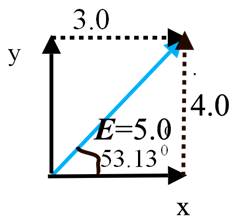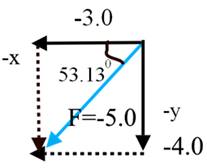
Concept explainers
(a)
The horizontal and vertical components of the given vector.
(a)
Answer to Problem 56A
The horizontal and vertical components of the vector E are
Explanation of Solution
Given:
A vector E with its length 5. Up and positive directions are assumed positive.
Formula Used:
The horizontal and vertical component of a vector R is given by,
The length or magnitude of a vector is expressed as,
The angle is given by,
Calculation:
For the given magnitude of the vector E which is 5.0 units, the possible perfect square components of the vector are given by,
The choice of vector components is made so based on the angle made by the vector with the horizontal. The y-component being 4.0 units and the x-component being 3.0 units makes the angle close to 60 degrees which is evident from the given Figure 1.

Figure 1
The angle can be calculated as,
Thus, the horizontal and vertical components of the given vector E can be summarized as,
Conclusion:
The horizontal and vertical components of the given vector is
(b)
The horizontal and vertical components of the given vector.
(b)
Answer to Problem 56A
The horizontal and vertical components of the vector F are
Explanation of Solution
Given:
A vector F with its length -5.0. Up and positive directions are assumed positive.
Formula Used:
The horizontal and vertical component of a vector R is given by,
The length or magnitude of a vector is expressed as,
The angle is given by,
Calculation:
For the given magnitude of the vectorF which is -5.0 units, the possible perfect square components of the vector are given by,
The choice of vector components is made so based on the angle made by the vector with the horizontal. The y-component being -4.0 units and the x-component being -3.0 units makes the angle close to 60 degrees which is evident from the given Figure 1.

Figure 2
The angle can be calculated as,
Thus, the horizontal and vertical components of the given vector F are,
Conclusion:
The horizontal and vertical components of the given vector are
(c)
The horizontal and vertical components of the given vector.
(c)
Answer to Problem 56A
The horizontal and vertical components of the vector Aare
Explanation of Solution
Given:
A vector A with its length -3.0. Up and positive directions are assumed positive.
Formula Used:
The horizontal and vertical component of a vector R is given by,
The length or magnitude of a vector is expressed as,
The angle is given by,
Calculation:
For the given magnitude of the vectorA which is -3.0 units, it is evident from the Figure 3 that, the vector has only a horizontal component, in the negative direction.

Figure 3
Thus, the horizontal and vertical components of the given vector A are,
Conclusion:
The horizontal and vertical components of the given vector are
Chapter 5 Solutions
Glencoe Physics: Principles and Problems, Student Edition
Additional Science Textbook Solutions
Chemistry
Brock Biology of Microorganisms (15th Edition)
Campbell Biology in Focus (2nd Edition)
Organic Chemistry (8th Edition)
Campbell Biology: Concepts & Connections (9th Edition)
Campbell Biology (11th Edition)
- 4 1.00 mol of oxygen gas (O2) is heated at a constant pressure of 1.00 atm from 10.0°C to 25.0°C. How much heat is absorbed by the gas? Multiple Choice О 389 J о 544 J О 436 J О 288 Jarrow_forwardIL 6. For the sentence, why are the red lines representing the formants and the blue line representing the fundamental frequency always angled instead of horizontal?arrow_forwardCH 57. A 190-g block is launched by compressing a spring of constant k = = 200 N/m by 15 cm. The spring is mounted horizontally, and the surface directly under it is frictionless. But beyond the equilibrium position of the spring end, the surface has frictional coefficient μ = 0.27. This frictional surface extends 85 cm, fol- lowed by a frictionless curved rise, as shown in Fig. 7.21. After it's launched, where does the block finally come to rest? Measure from the left end of the frictional zone. Frictionless μ = 0.27 Frictionless FIGURE 7.21 Problem 57arrow_forward
- 3. (a) Show that the CM of a uniform thin rod of length L and mass M is at its center (b) Determine the CM of the rod assuming its linear mass density 1 (its mass per unit length) varies linearly from λ = λ at the left end to double that 0 value, λ = 2λ, at the right end. y 0 ·x- dx dm=λdx x +arrow_forwardShrinking Loop. A circular loop of flexible iron wire has an initial circumference of 161 cm , but its circumference is decreasing at a constant rate of 15.0 cm/s due to a tangential pull on the wire. The loop is in a constant uniform magnetic field of magnitude 1.00 T , which is oriented perpendicular to the plane of the loop. Assume that you are facing the loop and that the magnetic field points into the loop. Find the magnitude of the emf E induced in the loop after exactly time 9.00 s has passed since the circumference of the loop started to decrease. please show all stepsarrow_forwardAromatic molecules like those in perfume have a diffusion coefficient in air of approximately 2×10−5m2/s2×10−5m2/s. Part A Estimate, to one significant figure, how many hours it takes perfume to diffuse 2.5 mm, about 6.5 ftft, in still air. Express your answer in hours to one significant figure.arrow_forward
- Rocket Science: CH 83. A rocket of mass M moving at speed v ejects an infinitesimal mass dm out its exhaust nozzle at speed vex. (a) Show that con- servation of momentum implies that M dy = vex dm, where dy is the change in the rocket's speed. (b) Integrate this equation from some initial speed v; and mass M; to a final speed vf and mass Mf Vf to show that the rocket's final velocity is given by the expression V₁ = V¡ + Vex ln(M¡/M₁).arrow_forwardFormant Freqmcy The horizontal dotted lines represent the formants. The first box represents the schwa sound. The second box is a different vowel. The scale is the same on each of these two vowels. Use the two formant contours to answer questions 12-16 SCHWA VOWEL 2 0.179362213 Time (s) 0.92125285 0.0299637119 4000 1079 Time(s) unknown 0.6843 13. Please describe what the tongue is doing to shift from the schwa to vowel 2? 14. Is vowel 2 a rounded or unrounded vowel? 15. Is vowel 2 a front or back vowel? 16. What vowel is vowel 2 (00, ee, ah) 0684285714arrow_forwardmicrowavearrow_forward
- 4) Consider the pulley (Mass = 20kg, Radius 0.3m) shown in the picture. Model this pulley as a uniform solid disk (1 = (1/2) MR2) that is hinged at its center of mass. If the hanging mass is 30 kg, and is released, (a) compute the angular acceleration of the pulley (b) calculate the acceleration of the hanging mass. A o 0.3 3019 20KSarrow_forwardRefer to the image attachedarrow_forwardShrinking Loop. A circular loop of flexible iron wire has an initial circumference of 161 cm , but its circumference is decreasing at a constant rate of 15.0 cm/s due to a tangential pull on the wire. The loop is in a constant uniform magnetic field of magnitude 1.00 T , which is oriented perpendicular to the plane of the loop. Assume that you are facing the loop and that the magnetic field points into the loop. Find the magnitude of the emf E induced in the loop after exactly time 9.00 s has passed since the circumference of the loop started to decrease. Find the direction of the induced current in the loop as viewed looking along the direction of the magnetic field. Please explain all stepsarrow_forward
 College PhysicsPhysicsISBN:9781305952300Author:Raymond A. Serway, Chris VuillePublisher:Cengage Learning
College PhysicsPhysicsISBN:9781305952300Author:Raymond A. Serway, Chris VuillePublisher:Cengage Learning University Physics (14th Edition)PhysicsISBN:9780133969290Author:Hugh D. Young, Roger A. FreedmanPublisher:PEARSON
University Physics (14th Edition)PhysicsISBN:9780133969290Author:Hugh D. Young, Roger A. FreedmanPublisher:PEARSON Introduction To Quantum MechanicsPhysicsISBN:9781107189638Author:Griffiths, David J., Schroeter, Darrell F.Publisher:Cambridge University Press
Introduction To Quantum MechanicsPhysicsISBN:9781107189638Author:Griffiths, David J., Schroeter, Darrell F.Publisher:Cambridge University Press Physics for Scientists and EngineersPhysicsISBN:9781337553278Author:Raymond A. Serway, John W. JewettPublisher:Cengage Learning
Physics for Scientists and EngineersPhysicsISBN:9781337553278Author:Raymond A. Serway, John W. JewettPublisher:Cengage Learning Lecture- Tutorials for Introductory AstronomyPhysicsISBN:9780321820464Author:Edward E. Prather, Tim P. Slater, Jeff P. Adams, Gina BrissendenPublisher:Addison-Wesley
Lecture- Tutorials for Introductory AstronomyPhysicsISBN:9780321820464Author:Edward E. Prather, Tim P. Slater, Jeff P. Adams, Gina BrissendenPublisher:Addison-Wesley College Physics: A Strategic Approach (4th Editio...PhysicsISBN:9780134609034Author:Randall D. Knight (Professor Emeritus), Brian Jones, Stuart FieldPublisher:PEARSON
College Physics: A Strategic Approach (4th Editio...PhysicsISBN:9780134609034Author:Randall D. Knight (Professor Emeritus), Brian Jones, Stuart FieldPublisher:PEARSON





